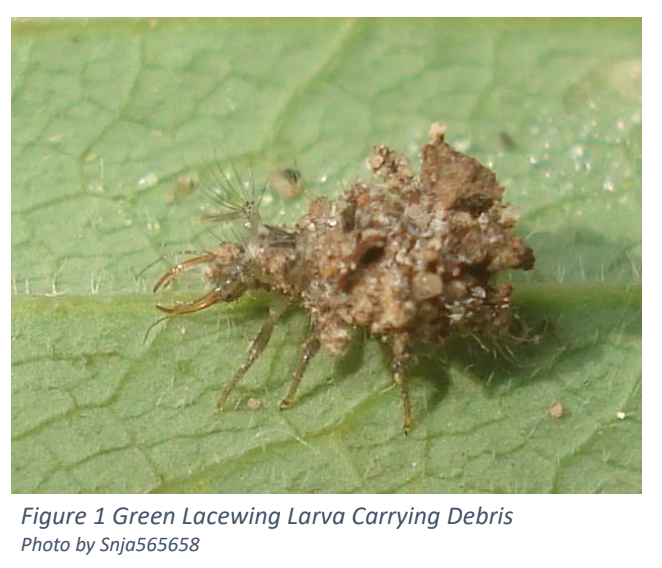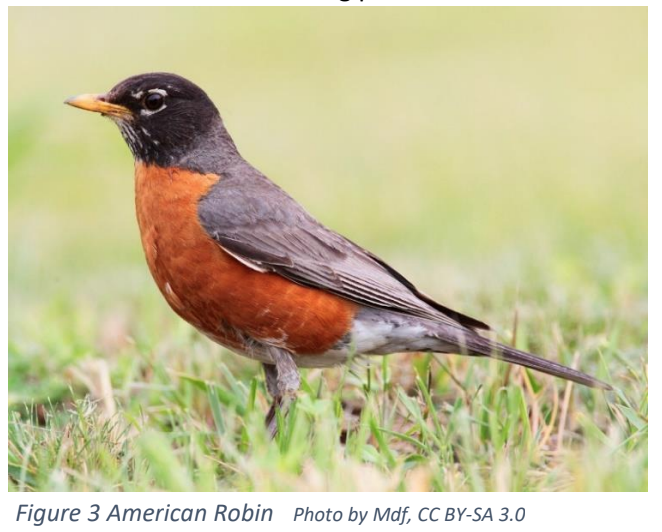
Ladybug pupa on newly planted Chestnut Oak (Quercus montana) on The Mall. Ladybugs (Family: Coccinellidae) undergo complete metamorphosis and have four distinct stages of development: egg, larva, pupa, and adult. Over its lifespan, a single ladybug will eat about 5000 aphids.
By Christine Helie, Consulting Entomologist, The Growing Tree
Biological Control
Insects that prey upon other insects are considered beneficial and play an important role in maintaining the health of our landscapes. Supporting populations of beneficial insects or using them to suppress harmful insects is an essential strategy in any Integrated Pest Management program (IPM).
Chrysoperla rufilabis, a native species of green lacewing, is commercially available for periodic release in greenhouses or landscapes and is a natural enemy of many insects that are injurious to trees. As generalist predators, the tiny green lacewing larvae provide a vital service by eating aphids, small caterpillars, beetles, leafhopper nymphs, thrips, mites, whiteflies, mealybugs, and even insect eggs.
Since 2019, we have been augmenting the existing population of Chrysoperla rufilabis in the three parks with those purchased from insectaries. This year we released 3000 of these green lacewing larvae to the Public Garden, the Boston Common, and Commonwealth Avenue Mall.
 A Wolf in Sheep’s Clothing
A Wolf in Sheep’s Clothing
Chrysoperla rufilabis is just one type of green lacewing that lives in our parks. There are several other species of green lacewing whose larvae help manage harmful insects and in some of these species, the larvae have a unique way of attacking their prey. Known as debris carriers, the green lacewing larvae will place plant material, lichens, aphid carcasses, sand, and even small snail shells on their backs. By disguising themselves in this way the green lacewing larvae can sneak up on colonies of aphids unnoticed. This behavior also allows them to avoid detection by predators such as ants that may be protecting the aphids for their honeydew.
Spotlight on Insect and Spider Inventory
As time allows, I continue to identify the by-catch insects and arachnids that are found on our elm bark beetle traps. Identifying the non-target insects on the traps is fundamental to knowing more about them, such as their diet or habitat requirements. Getting familiar with them enables us to see their connection to other species which will lead to a greater knowledge of the whole ecosystem in the parks.
 In the Public Garden this year, a Say’s Mantidfly was found on the Kentucky Coffee tree trap. Say’s Mantidfly (Dicromantispa sayi) is a fantastic natural predator whose common and scientific names are based on its resemblance to a praying mantis. Adult mantidflies are active hunters and similar to praying mantids, they use their raptorial front legs to catch a wide variety of insects. The larval stage of Say’s Mantidfly however, feeds exclusively on spiders. Soon after hatching from their eggs, larval mantidflies will search for and enter spider egg sacs or hitch a ride on female spiders where they can enter a spider egg sac as it is being created.
In the Public Garden this year, a Say’s Mantidfly was found on the Kentucky Coffee tree trap. Say’s Mantidfly (Dicromantispa sayi) is a fantastic natural predator whose common and scientific names are based on its resemblance to a praying mantis. Adult mantidflies are active hunters and similar to praying mantids, they use their raptorial front legs to catch a wide variety of insects. The larval stage of Say’s Mantidfly however, feeds exclusively on spiders. Soon after hatching from their eggs, larval mantidflies will search for and enter spider egg sacs or hitch a ride on female spiders where they can enter a spider egg sac as it is being created.
Bugs are for the Birds
Since many birds include insects in their diet, they are an important component of any insect management plan. The American Robin (Turdus migratorius), a familiar bird in the urban environment, is well known for its diet of earthworms but insects make up a majority of their nutrition in the spring and summer. This summer, while monitoring our elm bark beetle traps, Norm and I were witnesses to how effective American Robins are in eliminating pest insects.
 Every monitoring season, the three-sided wooden box that holds our elm bark beetle traps becomes a snug home for several insects and spiders. Long-legged sac spiders, tan jumping spiders, Orb-weaver spiders, gypsy moth caterpillars, underwing moths and especially earwigs nestle in the thin protected space between the sticky trap and the box. On certain traps it is not unusual to find several broods of young earwigs sheltering with their mothers in the corners of the box just behind the sticky paper. As a result, when the sticky paper is removed from the box, many of these earwigs lose their footing and dozens drop to the ground below.
Every monitoring season, the three-sided wooden box that holds our elm bark beetle traps becomes a snug home for several insects and spiders. Long-legged sac spiders, tan jumping spiders, Orb-weaver spiders, gypsy moth caterpillars, underwing moths and especially earwigs nestle in the thin protected space between the sticky trap and the box. On certain traps it is not unusual to find several broods of young earwigs sheltering with their mothers in the corners of the box just behind the sticky paper. As a result, when the sticky paper is removed from the box, many of these earwigs lose their footing and dozens drop to the ground below.
One trap that attracts a lot of earwigs is on a pagoda tree near the Carousel on the Boston Common. During a monitoring day this summer, while I was removing the sticky paper at this trap, countless numbers of earwigs began falling to the ground. Only a short distance away was an American Robin intently watching and as the earwigs continued to drop, the Robin quickly made its way to the base of this tree and began eating every earwig it could catch. It was a spectacular display and we actually found ourselves cheering for the Robin as it devoured all the earwigs that had just rained down from the tree. Not only do insects serve as food for adult birds, but 96 percent of terrestrial birds rear their young on insects.
As some of our most efficient insect predators, birds are a necessary part of a successful Integrated Pest Management program.

